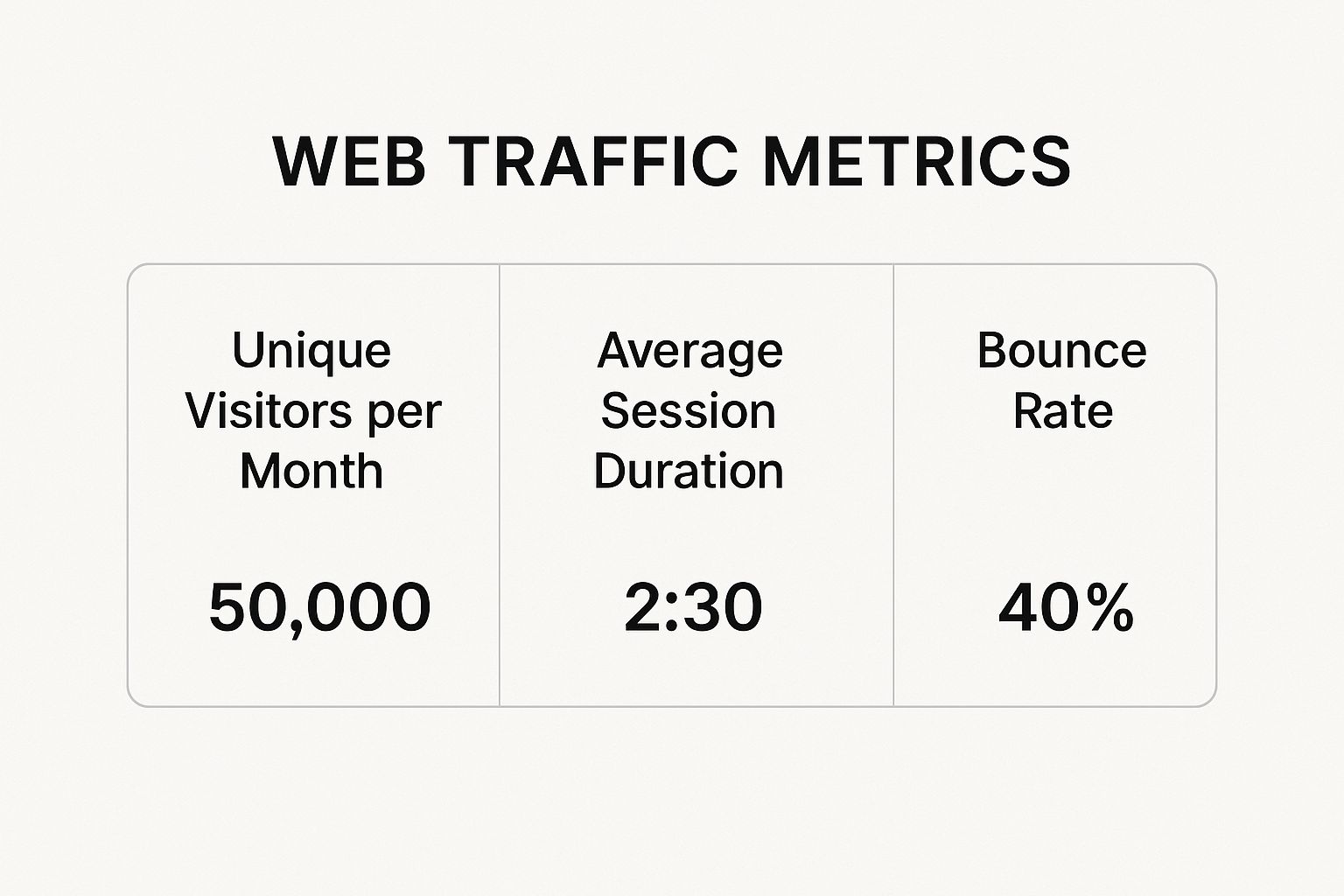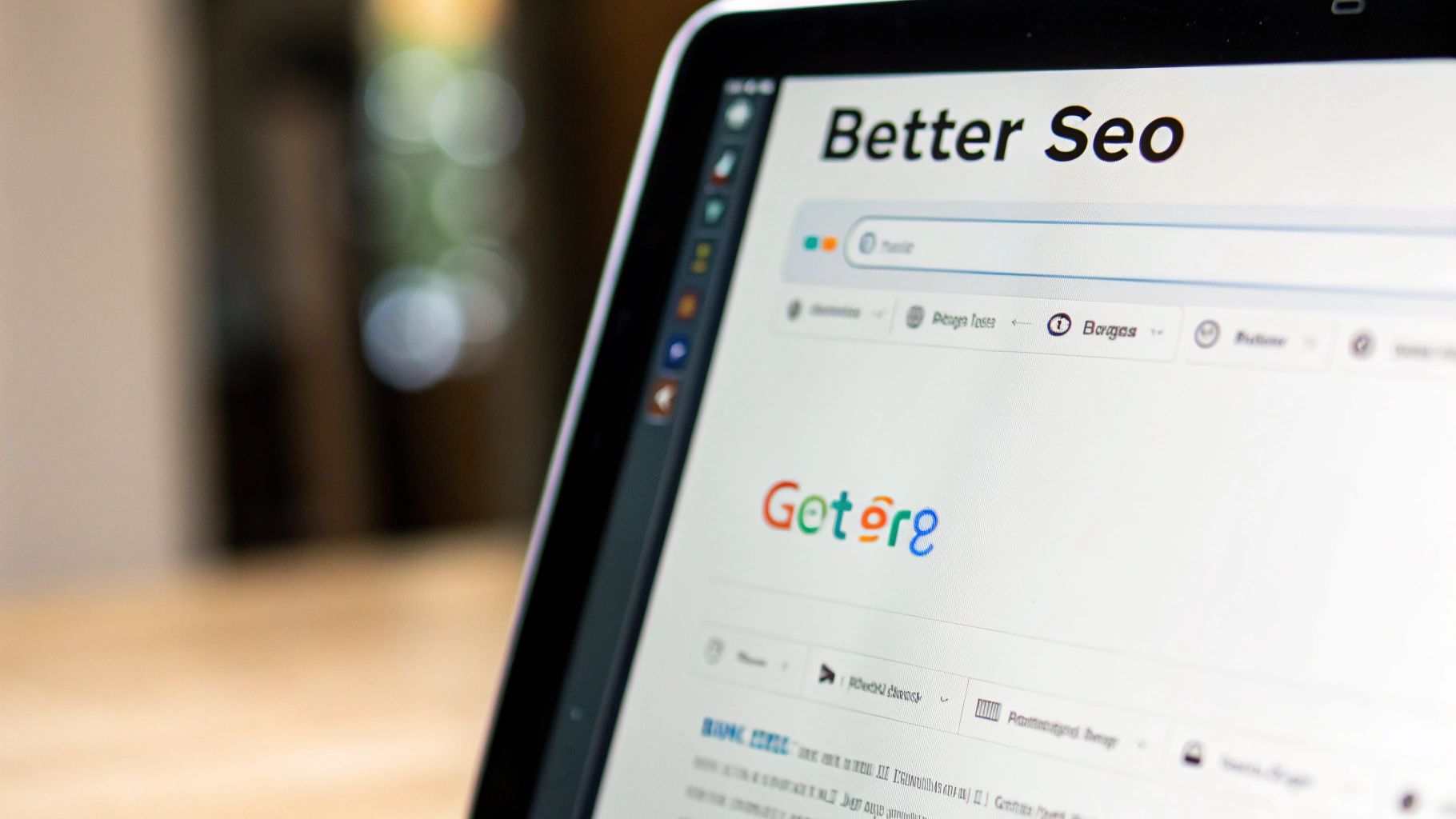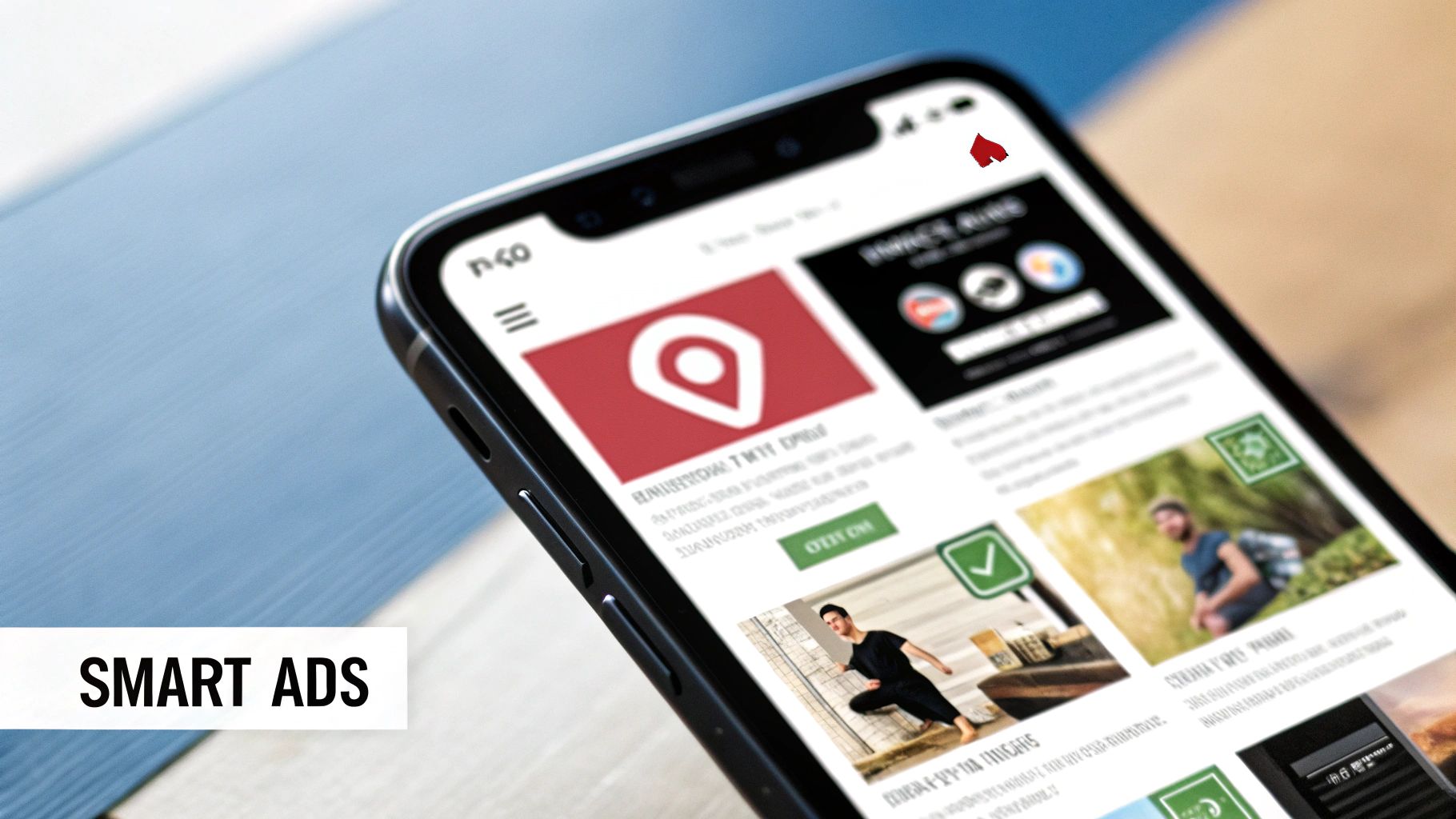Before you can even think about driving a ton of new traffic to your site, you need to get your house in order. That means building a rock-solid foundation, ensuring your website is both technically sound for search engines and a great experience for actual human visitors.
Think of it like getting a physical store ready for a grand opening. If the doors are locked, the aisles are a mess, and the lights are flickering, no one’s going to stick around, no matter how great your products are. The same is true for your website.
So many marketers and business owners get this backward. They jump straight into complex content strategies or expensive ad campaigns, all while their website's core structure is actively working against them.
Getting more website traffic isn't just about chasing new eyeballs. It’s about creating a place that both search engines and people genuinely love. To do that, you have to nail two things from the get-go: technical health and user experience.
First things first: Google has to be able to find and understand your stuff. A technically sound website is one that search engine crawlers can navigate effortlessly. If Google’s bots can’t efficiently access your pages, they can't index them properly. And if they can't index them, you're invisible in the search results. It's that simple.
A clean site architecture with logical, intuitive navigation is your first priority. This helps spread link authority throughout your site and guides both users and crawlers to your most important content.
Beyond just a clean structure, you need to make sure your site is easily discoverable. If you’re publishing new content but it feels like you're shouting into the void, you might need to give Google a little nudge. We have a whole guide on how to increase your Google crawl rate that’s packed with actionable steps to get your pages noticed faster.
Technical health gets you in the game, but a fantastic user experience (UX) is what helps you win. A visitor’s first impression is formed in seconds, and it determines whether they stick around or hit the back button.
You need to get these key elements right:
This is where you stop guessing and start looking at the data. Metrics like session duration, bounce rate, and unique visitors tell the real story of your site's health.

These numbers give you a clear, honest snapshot of your foundation's strength. They show you how many people are showing up, how long they’re staying, and how many are leaving almost immediately.
Getting this foundation right is non-negotiable because it directly impacts your ability to show up on the world's most dominant platform. Google still gets over 100 billion monthly visits as of mid-2025—a figure that completely dwarfs everyone else. If you're serious about traffic, you have to be visible there.
This table breaks down the foundational tasks that will set you up for success.
Action ItemPrimary GoalWhy It Drives TrafficOptimize Site SpeedImprove User ExperienceFaster pages reduce bounce rates and are favored by Google's algorithm, leading to better rankings.Ensure Mobile-FriendlinessMaximize ReachWith most searches happening on mobile, a responsive site is essential for capturing that traffic.Clean Up Site ArchitectureEnhance CrawlabilityA logical structure helps search engines find and index all your content, making more pages visible.Set Up Google AnalyticsTrack User BehaviorUnderstanding how users interact with your site helps you identify and fix issues that cause them to leave.
Nailing these fundamentals ensures that when you do start driving traffic, your website is ready to convert those visitors instead of scaring them away.
Of course, a strong organic foundation from SEO is just one piece of the puzzle. Paid strategies like PPC can deliver immediate traffic and valuable data while your long-term SEO efforts gain momentum. If you're looking to dip your toes in, this ultimate guide to PPC for businesses is a great place to start. A balanced approach often works best, combining long-term asset building with short-term wins.

Think of on-page SEO as the foundation of your house. If it’s not solid, nothing else you build on top will matter. It's how you signal to search engines what your content is about and why it deserves to rank, helping you climb the results and pull in more traffic. This is so much more than just sprinkling keywords on a page and hoping for the best.
It all starts with your title tag and meta description. These are your digital storefronts on the search engine results page (SERP). Your job isn’t just to rank—it’s to get the click. A sharp, compelling title that grabs attention and a meta description that promises a solution can seriously boost your click-through rate (CTR), even if you're not sitting in the #1 spot.
Pro Tip: Treat your meta description like a 155-character sales pitch. Don't just rehash the title. Ask a question, highlight a key benefit, or use a strong call-to-action that makes clicking irresistible.
Once a user clicks, your content’s structure is what keeps them there. Header tags (H1, H2, H3) are your best friends for this. They create a clean, logical hierarchy that makes your content easy for both humans and search engine bots to understand.
You get one H1 tag per page—that’s your main headline. Use H2s and H3s to break down your main points into smaller, scannable sections. This approach makes your content feel less like a wall of text and more like an easy-to-follow guide. It also gives Google clear signposts about the subtopics you're covering.
Internal linking is easily one of the most powerful—and most overlooked—on-page SEO tactics. It’s the simple act of linking from one page on your website to another relevant page. This isn't just busywork; it's a strategic move that accomplishes a few critical things:
Get into the habit of adding a few relevant internal links every time you publish a new post. It’s a small effort that builds a much stronger, more authoritative site over time. Of course, perfect internal linking won't matter if your pages aren't even in Google's database. Learning how to submit your website to search engines is a foundational step to make sure all your hard work gets seen.
Ultimately, getting these on-page elements right gives you a massive advantage. To take it even further, you should also explore proven strategies to outrank competitors by finding and exploiting the gaps in their own on-page efforts. A perfectly optimized page can absolutely beat a competitor with a bigger budget. It all comes down to mastering the fundamentals.

If you're still treating your mobile audience as an afterthought, you're actively killing your traffic. Thinking of mobile optimization as a "nice to have" is a surefire way to become irrelevant. Your audience isn't just sometimes on their phones—they live there.
The data backs this up, and the numbers are staggering. As of July 2025, a massive 64.35% of all global web traffic comes from mobile devices. To put that in perspective, that figure has exploded by over 8,800% since 2009. If your site isn't built for a small screen, you're deliberately ignoring the vast majority of your potential visitors. You can dig into the mobile traffic trends yourself to see just how dominant this shift has become.
Let's be clear: a "responsive design" that just squishes your desktop site onto a smaller screen isn't going to cut it anymore. Real mobile optimization is about crafting a fast, intuitive, and seamless experience for someone on the go.
Mobile users are impatient. A clunky, slow-loading site on a spotty cellular connection is a guaranteed way to lose a visitor before they even see your headline. Google knows this, which is why Core Web Vitals and overall page speed are huge ranking factors, especially for mobile search results.
Here are a few practical things you can do right now to speed up your site on mobile:
Beyond pure speed, the usability of your site on a small screen is make-or-break. Can someone easily navigate your menu with their thumb? Is the text readable without pinching and zooming?
The best mobile designs feel effortless. They anticipate what the user needs, making buttons large enough to tap, text legible from a distance, and navigation dead simple. And for the love of all that is holy, avoid intrusive pop-ups—they are especially infuriating on mobile and a top reason for users to bounce immediately.
Content is the engine that drives your entire traffic strategy. But here’s a hard truth: churning out blog posts without a clear purpose is one of the fastest ways to burn through your budget and time. If you want more website traffic that actually converts, you have to create content with a very specific person and goal in mind.
This means getting out of your own head and stop making assumptions about what people want to read. The foundation of any killer content plan is built on deeply understanding the precise problems, questions, and pain points your audience has. Your job is to show up with the best, most thorough answers.
Great content always starts with smart keyword research. This isn't about awkwardly stuffing keywords into your articles. It’s about discovering the exact language your potential customers use when they turn to Google for help. When you get the keywords right, you're aligning your content directly with user demand.
And think beyond those simple one-word queries. The real gold is in long-tail keywords—longer, more specific phrases like "how to fix a leaky faucet under the sink" instead of just "plumbing." These are incredibly valuable. Why? Because they usually have lower competition and attract highly motivated visitors who know exactly what they need.
By focusing on the specific problems your audience is trying to solve, you create a direct path for them to find your website. Each piece of content becomes a solution waiting to be discovered.
Once you have a list of potential topics, the next step is mission-critical: analyzing search intent. You have to figure out why someone is searching for that term. Are they looking to learn something (informational), compare options (commercial), or buy something right now (transactional)? Matching your content to the user's intent is non-negotiable if you want to rank.
A blog is a fantastic starting point, but it shouldn’t be your only play. Diversifying your content formats is key to attracting different segments of your audience and earning valuable backlinks from other sites. To really connect with your ideal audience, you'll need a mix of engaging content; you can explore some top marketing content ideas to get the wheels turning.
Consider weaving these powerful formats into your strategy:
No matter which format you choose, remember that creating amazing content is only half the battle. You have to make sure search engines can find and index it—fast. After you hit "publish" on a new guide or video, you want it showing up in search results as soon as possible. Our guide on achieving instant indexing gives you the exact steps to get your content discovered without delay, maximizing its traffic potential from day one.

Hitting 'publish' on a new article can feel like the end of the road, but in reality, it’s just the beginning. The most brilliant, data-driven post on the internet is completely useless if no one ever sees it. To get real traffic, you need a proactive promotion strategy that shoves your content in front of the right eyeballs and builds your site’s authority over time.
Think of it this way: without promotion, you’re just hoping people stumble upon your work in the vastness of the web. With a solid plan, you turn every new article into an asset that works for you, creating a flywheel effect where each piece builds momentum, attracts links, and drives valuable referral traffic.
Just dropping a link onto your social media profiles and calling it a day isn't going to cut it. You have to speak the language of each platform to get any real engagement.
For example, on LinkedIn, you might pull a professional insight from your article and frame it for a business audience. Over on X (formerly Twitter), a punchy statistic or a provocative question from the same article will perform much better.
The goal here isn't just to broadcast a link; it's to start a conversation. The more you can get people to comment, share, and click, the more the platform's algorithm will reward you by showing your post to new audiences. That initial push is absolutely crucial for getting early traction.
Let's be clear: backlinks are one of the most powerful ranking signals for search engines. They are essentially votes of confidence from other websites, and earning them is an art form. One of the most reliable ways to do this is through targeted email outreach.
This isn't about blasting a generic template to hundreds of random sites. It’s about strategic, personalized communication.
First, you need to find websites, blogs, or even resource pages that have already linked out to content similar to yours. SEO tools are perfect for uncovering these opportunities. Once you have a list, you craft a personalized email that clearly explains:
A great outreach email isn't a demand; it's a value proposition. Instead of saying, "Please link to my post," frame it as a helpful suggestion. Try something like, "I saw you linked to [an older resource], and I just published a more current guide that I think your audience would get a lot of value from." This collaborative, non-pushy approach will dramatically increase your success rate.
Guest posting on other reputable sites in your niche is a classic SEO strategy for a reason: it works. It’s a powerful two-for-one punch that gets your name and expertise in front of a brand new, relevant audience while securing a high-quality backlink to your own website.
Your first step is to find blogs that accept guest posts and have an engaged readership. Then, pitch them unique, high-value topic ideas that aren't just a rehash of what's already on your own site. When you write for someone else, your primary mission is to provide overwhelming value to their audience. In return, you'll earn credibility, referral traffic, and a powerful link that boosts your own site's authority.
Of course, tracking the impact of all this work is essential. By setting up an SEO performance dashboard, you can directly monitor the referral traffic coming from your guest posts and outreach campaigns. This gives you a crystal-clear picture of which promotional strategies are actually moving the needle, allowing you to double down on what works and ditch what doesn't.
Even with the best strategy in place, questions always pop up. It's just part of the process of growing a website. Let's tackle some of the most common ones I hear from clients and in forums. Getting these sorted will give you the clarity you need to push forward with confidence.
Think of this as your quick-reference guide for those moments when you're staring at your analytics and wondering, "Am I on the right track?"
This is the million-dollar question, and the honest answer is: it depends. The timeline for real, meaningful traffic growth is tied directly to your niche, how much authority your site currently has, and—most importantly—how consistently you're putting in the work.
For quick wins like technical fixes and on-page SEO tweaks, you can often see the first glimmers of hope within 1 to 3 months. This might look like a small bump in rankings for a few keywords or a handful of extra clicks from search.
But for the kind of significant, sustainable traffic that comes from great content and authoritative backlinks, you have to play the long game. It usually takes a solid 6 to 12 months of consistent effort to see a major impact. It’s like planting a tree—it needs time to establish strong roots before it can really grow.
Sustainable traffic growth is a marathon, not a sprint. You can always get a short-term boost from paid ads, but true organic success is built month after month through patient, consistent effort.
The smartest approach usually involves a mix of both. Paid and organic traffic aren’t enemies; they're teammates that serve different, complementary purposes.
A balanced strategy uses paid ads for immediate, targeted goals while you steadily invest in SEO to build a durable foundation that pays for itself over and over again.
Just looking at "total visits" won't tell you the whole story. If you want to really understand what's working and how to get more of the right kind of traffic, you need to look at more specific metrics.
Here are the key metrics I always monitor:
Ready to stop waiting for search engines to find your new content? IndexPilot automates the indexing process, ensuring your latest pages are submitted to Google and Bing the moment they go live. Accelerate your SEO results and maximize your traffic potential. Start your 14-day free trial at https://www.indexpilot.io and get your content seen faster.